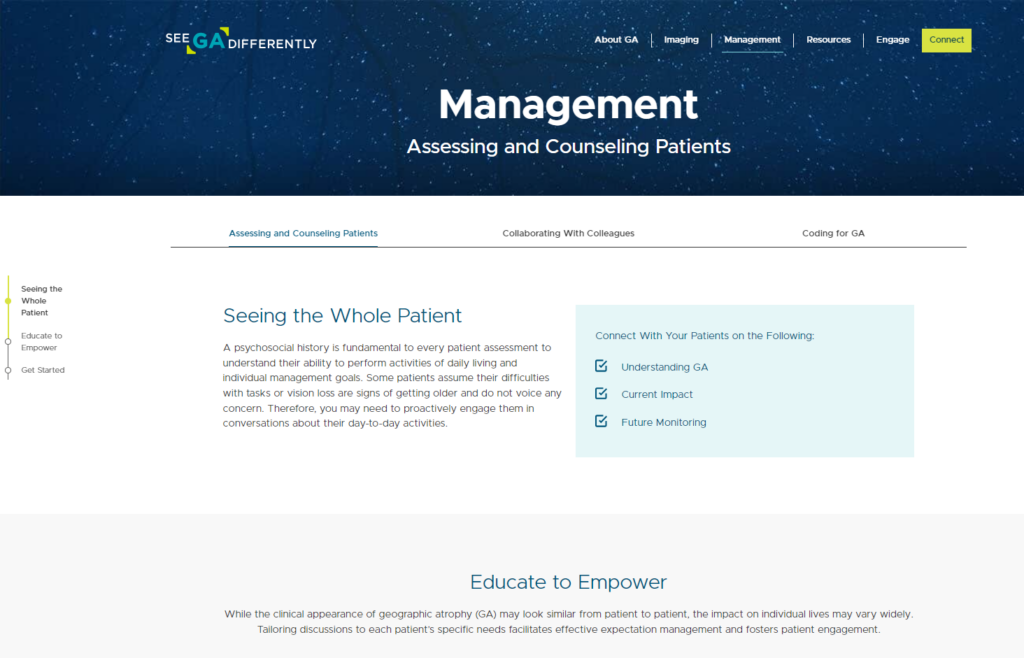

As one of the ODs at Ohio’s Cincinnati Eye Institute, Mary Beth Yackey, OD, often sees patients with progressing ocular diseases. Patients who are symptomatic already understand that they are losing vision. Some are coming in for anti-VEGF injections for their age-related macular degeneration, or they’ve been through that process with an older family member.
Dr. Yackey is often the one who has the difficult discussion with patients about the prognosis and the available options. “The treatments that are available will not stop progression of the disease process, but we are trying to slow it down,” she tells them. “If we can do that, we can buy them some time as research continues into treatment.”
The conversation can be particularly challenging however with patients who are just beginning to experience geographic atrophy (GA). GA is the advanced form of dry age-related macular degeneration (AMD) and is defined by the presence of sharply demarcated atrophic lesions of the outer retina, retinal pigment epithelium and choriocapillaris.1,2
Often, these patients who are just beginning to experience symptoms will complain that they are having difficulty reading. “Without intervention, if they’re missing a letter now, it will become missing a word and then the page. It’s a matter of time, but I cannot tell patients how quick that point will be,” she says. What she emphasizes is that GA is a question of visual function, not acuity. “It’s easier for patients to understand that we are trying to keep them able to drive and function as along as possible.”
TECHNOLOGY TO SUPPORT DIAGNSOIS
Dr. Yackey uses multiple imaging options to create a baseline and follow patients. Optical coherence tomography (OCT) imaging, fundus autofluorescence (FAF) and color fundus photography each supply valuable data. “We can show them where there is growth, but it’s more than the clinical presentation. We sometimes struggle with the right verbiage to talk about functional vision,” she says.
So the approach has to be equal parts imaging and listening. The OCT is a gold standard for monitoring GA, and she recommends using the en face feature on OCT imaging as an educational tool for patients. “But we also have to listen. This isn’t just assessing the acuity, but we need to ask if they’re experiencing challenges with reading or night driving, for example.”
ADVANCES IN MANAGEMENT
For the 20 years that Dr. Yackey has been practicing, there was not much that eye care professionals could do for patients. “As a result, it wasn’t really on our radar. Why bring it up if there was nothing we could offer?”
But that’s changing – and patients are grateful for the research and development that is going into GA. “When I tell them about the research, we’ve had people leave crying. They have never had hope before.”
As Dr. Yackey and her colleagues await developments, she is helping patients manage their expectations. “We do anticipate genetic treatments in the future or treatments that will act closest to target the problem and slow down photoreceptor damage. And in the meantime, there are developments that can help slow progression until there are more options.
In April, Iveric Bio reported that in clinical trials in an interventional study, patients treated with avacincaptad pegol suggested that a reduction of growth in GA resulted in an overall lower rate of vision loss. The data signaled a 56% risk reduction in the rate of persistent vision loss in GA patients.
PATIENT MOTIVATION
Addressing patient motivation is important, too. Coming into an office for monthly injections is not for everyone, she says. “Is the option going to cause issues with anxiety or anticipation? Will the cost be covered by insurance? Is the patient’s GA not too far advanced?”
That’s a conversation that primary care ODs who look for GA can have. “If patients are motivated and desire care to slow down the progression of vision loss, then those patients should be referred to retina. “Ultimately, we have this good outlook that can be very appealing to anyone who has had a family member go through vision loss.”
Plus, these preliminary diagnoses and discussions are within the scope of primary care optometrists. As more products and treatments become available, protocols are more likely to be streamlined as well. “I have worked with about 10 retina specialists, and all have slightly different protocols. But several say that the sooner the intervention starts, the better the outcome for saving vision for a longer term. If we do nothing, the condition will get worse. If we do something, we can hope to preserve vision longer.”
Learn More


Iveric Bio has developed a two-page PDF that identifies key factors in identifying GA, considerations for referral and how to manage patient discussions and education.
You can download the guide here or learn more about GA, including identifying GA and managing patients at seegadifferently.com.
References:
- Fleckenstein M, Mitchell P, Freund KB, et al. The progression of geographic atrophy secondary to age-related macular degeneration. Ophthalmology. 2018;125(3):369-390.
- Sadda SR, Chakravarthy U, Birch DG, Staurenghi G, Henry EC, Brittain C. Clinical endpoints for the study of geographic atrophy secondary to age-related macular degeneration. Retina. 2016;36(10):1806-1822.
Read other stories about how ODs are detecting and talking with patients about GA here.
IZERVAYTM receives FDA approval. Read more here.
This content is independent editorial sponsored by Astellas. Astellas had no input in the development of this content. Astellas, formerly Iveric Bio.



